The Art Detective is a weekly column by Katya Kazakina for Artnet News Pro that lifts the curtain on what’s really going on in the art market.
Several months before her death in 1984, artist Alice Neel appeared on Johnny Carson’s “Tonight Show.” The talk show host introduced his guest as “one of the most famous American portrait artists. A lovely lady. She is 84 years old.”
Clad in a glittering pastel blue dress and leaning on a cane, Neel looked like a bohemian babushka. Charming, irreverent and grandmotherly, she had Carson in stitches, comparing him to a “decadent Prince of Wales” and speaking of her exes as “first Latin” and “second Latin.”
“Why is it that it takes some time, a long time, for people to recognize artistic talent?” Carson asked amid bursts of laughter.
It’s a question art experts had been asking about Neel for decades prior—and ever since.
“To some extent, we are still grappling with it,” said Randall Griffey, who co-curated “Alice Neel: People Come First,” a blockbuster survey of some 100 paintings, watercolors, and drawings at the Metropolitan Museum of Art.
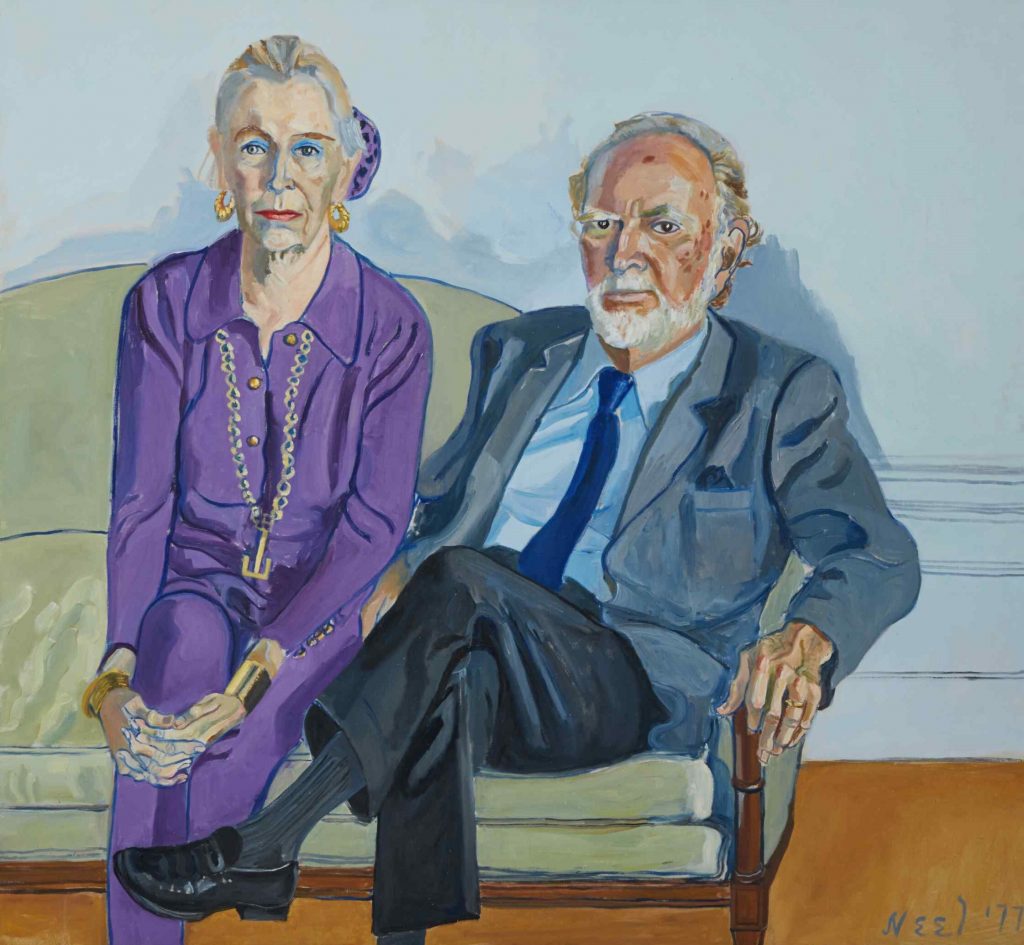
Alice Neel, Henry and Sally Hope (1977). Courtesy of Sotheby’s.
While thousands of people have come out to see the show since it opened in March, it’s the first such retrospective in more than two decades. And while Neel’s prices are setting auction records, they still lag those of living contemporary painters Dana Schutz, Amy Sherald, and Avery Singer.
Best known for her intensely intimate and gritty portraits—of pregnant women, naked men, eccentric couples, and her Spanish Harlem neighbors—Neel worked in traditional genres while the art world embraced new movements such as Abstract Expressionism and Pop art.
“The history of 20th-century art has been written as a succession of ‘isms,’” Griffey said. “And it’s really difficult to associate her with an ‘ism.’”
Neel flirted with Socialist Realism in the 1930s, but her work wasn’t “anything like Thomas Hart Benton or any of the artists of that generation,” he said. “Then she devoted most of her practice to what she called ‘pictures of people.’”
At a time when male-dominated Abstract Expressionism was all the rage, she focused on the figure. Painting on a domestic instead of a heroic scale, she depicted those around her: local boys and girls, her children, and later their spouses and kids. Eventually, there would be members of her social circle, people like Andy Warhol, the art critic John Perreault, and feminist scholar Linda Nochlin.
“There are an awful lot of abstractionists that wouldn’t do a figure,” she told Carson in 1984. “But as for me, I felt that the best record of life and everything else was figures. So I went against the grain. And you get punished for that.”
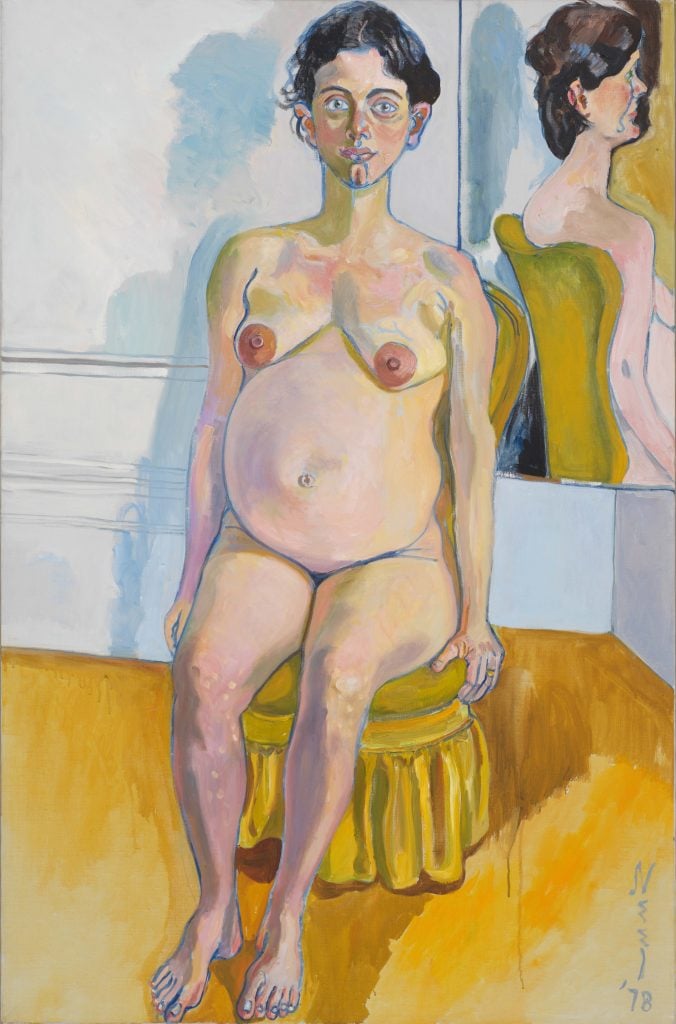
Alice Neel, Margaret Evans Pregnant (1978). © The Estate of Alice Neel.
Working in cluttered uptown apartments, she didn’t focus on selling works. Painting was an obsession, a way to analyze people around her and remain true to herself. She was 74 when the Whitney organized her first solo museum show. Art history programs didn’t mention her.
“Kelly and I both commiserated multiple times that neither one of us was taught Neel in our education in undergraduate or even in graduate schools,” Griffey said, referring to co-curator Kelly Baum.
“We love her work, but it hasn’t been part of the mainstream dialog for so long,” said Nicole Schloss, co-head of contemporary art day sales at Sotheby’s.
Schloss included Neel’s 1977 portrait, Henry and Sally Hope, in her auction on May 13, where it fetched $1.6 million with fees, surpassing the high estimate of $1.2 million. A few hours later, Neel’s 1966 still life with flowers, Dr. Finger’s Waiting Room, sold for $3 million at Christie’s evening sale of 20th-century art, smashing the $1.65 million record that’s been in place since 2009.
For many years, Neel and later her estate worked with with Robert Miller Gallery in New York, which represented several significant (and undervalued) female artists, including Louise Bourgeois, Lee Krasner, Joan Mitchell, and Eva Hesse.
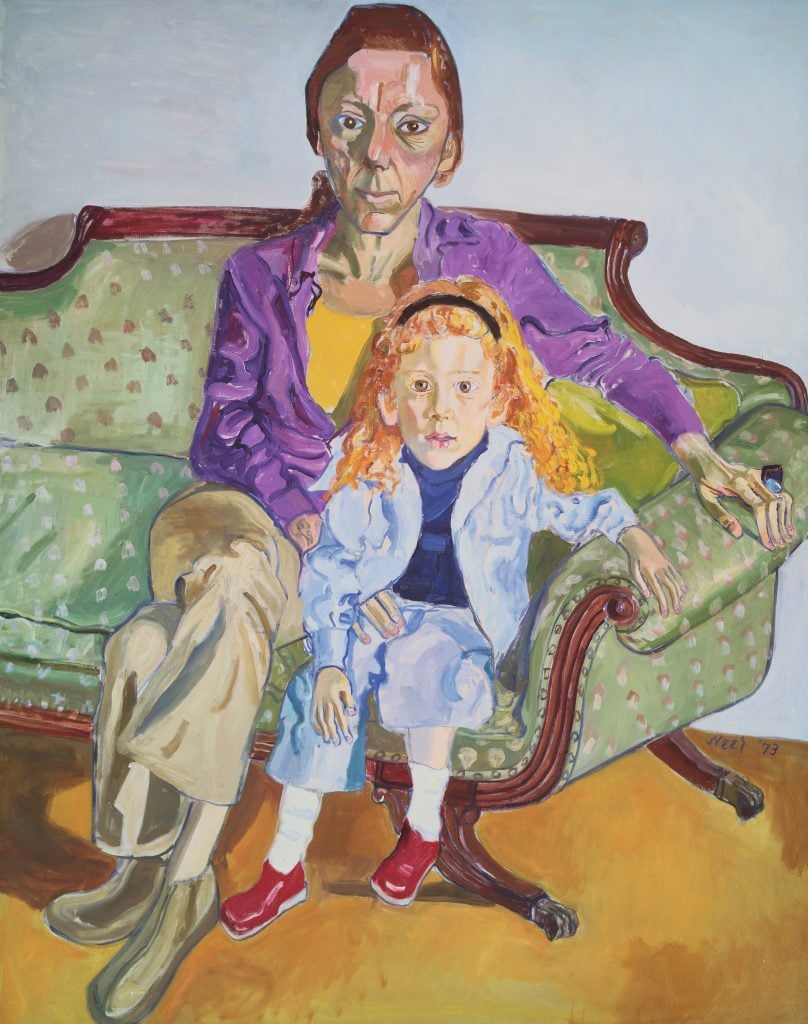
Alice Neel, Linda Nochlin and Daisy (1973). © The Estate of Alice Neel.
“Works did go to museums, but there wasn’t really a high demand at all,” said art adviser Kim Heirston, who worked as the gallery’s archivist in the late 1980s. Prices for paintings hovered between $50,000 and $75,000, she said.
She remembers how a gallery artist, Adam Fuss, walked in one day with two Neel paintings wrapped in brown paper bags. He had found them on a sidewalk, Heirston said.
Things began to change in 2000s, as a more pluralistic art world started taking shape—and as soaring prices pushed collectors to seek artists overlooked by the canon.
Christie’s executive Sara Friedlander remembers a gorgeous Alice Neel portrait of a young woman in a red blouse in her first-ever auction in 2007. Estimated at $50,000 to $70,000, it soared to $445,000.

Data © Artnet Price Database.
“I called every client I knew and said, ‘You have to start looking at Alice Neel,’” she said. “’She is the most important figurative painter of the 20th century. Go!’” Earlier this month, Friedlander’s client was the underbidder for Neel’s record-setting Dr. Finger’s Waiting Room.
Another factor leading to Neel’s reevaluation was her estate’s decision to work with David Zwirner, whose gallery has presented her work since 2008. The gallery has staged a number of important Neel shows, including “Uptown,” curated by Hilton Als in 2017. Through the gallery, the works have sold for more than $2 million.
“For a long time, her story was simplified as an eccentric older female painter, and these stereotypes were holding her back from people acknowledging her importance as a great artist,” said Bellatrix Hubert, a senior partner at Zwirner.
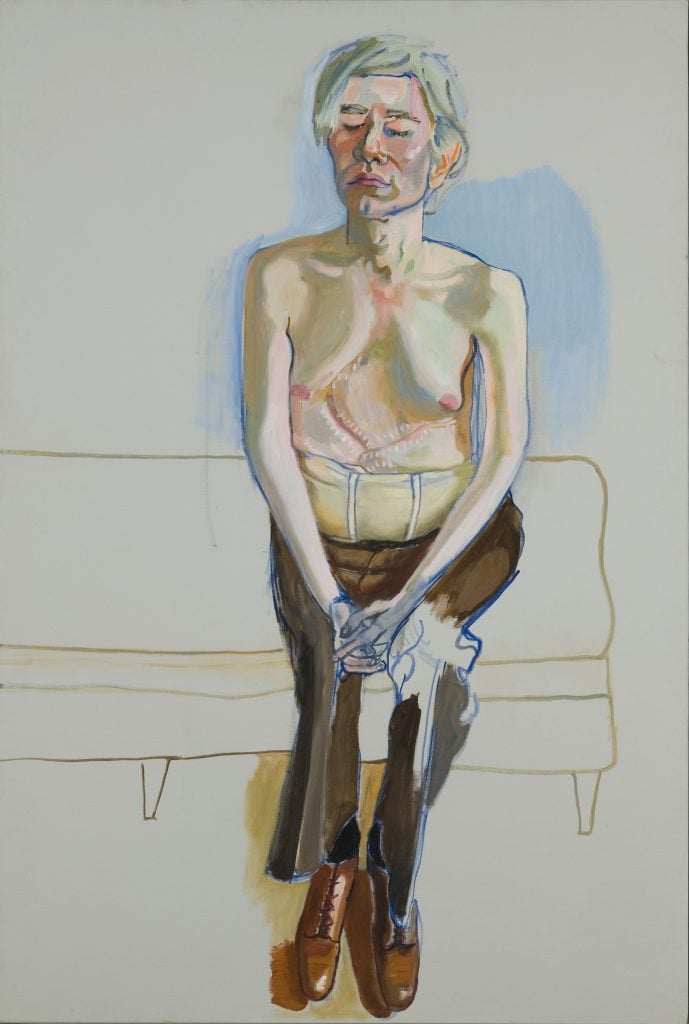
Alice Neel, Andy Warhol (1970). © The Estate of Alice Neel.
But the context has changed. The Met’s show arrives just as the art market is obsessed with figuration, and as portraiture is a thriving genre among a new generation of sought-after Black artists. Some, including rising star Jordan Casteel, have been vocal about Neel’s influence on their work.
“Where she really fits in is with the artists of today,” said art adviser Wendy Cromwell, “the psychosexual portrait painter.”
Neel’s influence is clear when her work is viewed alongside contemporary painters like Marlene Dumas and Elizabeth Peyton, said Brussels-based dealer Xavier Hufkens, whose gallery has worked with the Neel estate for eight years, organizing her first solo presentation in mainland China.
“It is partly thanks to the work of these later generations of artists that we can come to a better understanding of her oeuvre,” he said.
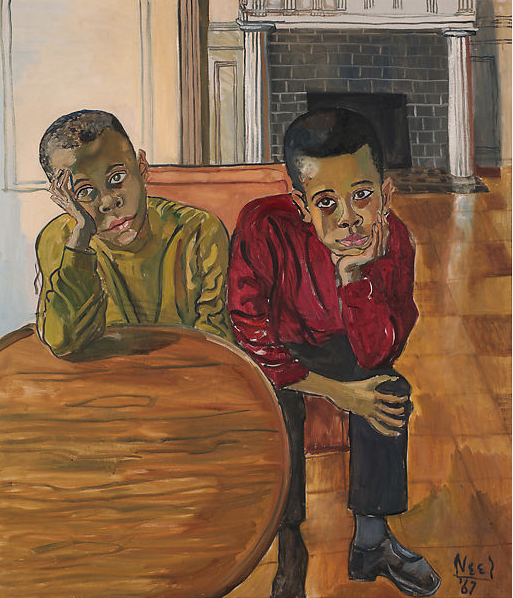
Alice Neel, The Black Boys (1967). © The Estate of Alice Neel.
Over the years, Neel’s visual language and life story resonated with prominent female collectors. The Met’s show opens with the hauntingly beautiful portrait Margaret Evans Pregnant, lent by the Institute of Contemporary Art, Boston, which received it from collector Barbara Lee.
Another painting in the show, Georgie Arce No. 2, has been lent to the Met by Museum of Modern Art trustee Lonti Ebers after last being sold at Sotheby’s for $728,000 in 2019.
Considering the esteem the show has gained among both popular crowds and the art cognoscenti, the gap between the prices her work achieves and the market’s expectation looks even odder. To whit, last summer, Neel’s portrait of Lilly Brody from Ginny Williams’s collection soared to $1 million, obliterating the estimated range of $50,000 to $70,000.
“She is an incredible case study of a woman who fought very hard to resist the conventional life and didn’t capitulate under pressure,” Griffey said. “Of course, the market has caught up with her.”
 Magnifying Glass
Magnifying Glass
A closer look at one work making waves in the market this week

Alice Neel, Black Draftee (James Hunter) (1965). © The Estate of Alice Neel.
One of the most striking paintings at the Met’s Neel show depicts a young Black man in an armchair. His head, face, and left hand are perfectly rendered, while the rest of the body is merely outlined in black on white.
Neel met the painting’s subject, James Hunter, by chance in 1965, the year U.S. President Lyndon B. Johnson decided to send more ground troops to Vietnam. Hunter had just been drafted and was scheduled to leave within a week, according to the exhibition catalogue.
During the first sitting, Neel outlined Hunter’s body directly on the canvas, as was her practice, and began filling in parts of the head and hands. That’s as far as she got. Hunter didn’t come back for additional sittings because he had shipped off to Vietnam. He never returned.
Neel left the painting as it was, declaring it finished and signing it, according to the catalogue. Nine years later, it was one of 58 portraits included in Neel’s Whitney retrospective, which took over the entire second floor of the Breuer building. The painting returned to the Breuer four decades later, when the Met rented it from the Whitney and staged its first exhibition, aptly titled “Unfinished.”
“It’s an amazing work of art on its own merit, but it was also a complete game-changer,” said Randall Griffey, the Met show’s co-curator. “It revealed to Neel the capacity of unfinishedness for aesthetic impact and even metaphoric impact. It looks like James Hunter is melting into thin air, underscoring the fragility of his life.”
Griffey credits his co-curator Kelly Baum with this insight. Neel, of course, would go on to use the technique in numerous later paintings (many on view in the Met show), leaving parts of her canvases untouched and unfilled.
“She learned how the canvas can do some of the work for her without having to apply paint,” Griffey said.
The painting is on loan from the COMMA Foundation in Belgium, according to the catalogue. The museum declined to provide additional information about the foundation. The entity, which doesn’t have a website, initially appeared a bit of a mystery, unknown even to active contemporary art collectors in Brussels.
But the Art Detective discovered that the foundation was set up by collectors Marc Ooms and Michael Vertessen on a historic farm in the town of Damme, near Bruges. The couple bought the painting at Art Basel in 2009 from Kunsthandel Haas in Berlin, who bought it from Aurel Scheibler, also in Berlin, who had it from the estate, Ooms confirmed in an email.
“At that moment Alice Neel wasn’t well known in Europe but we loved this painting from the moment we discovered it,” Ooms said. “What drew us to it was the look in his face. His eyes make really a strong connection with you.”
The work usually hangs in the couple’s home.
“We really miss it now, but we are also happy that we can share it with a lot of people,” Ooms said.
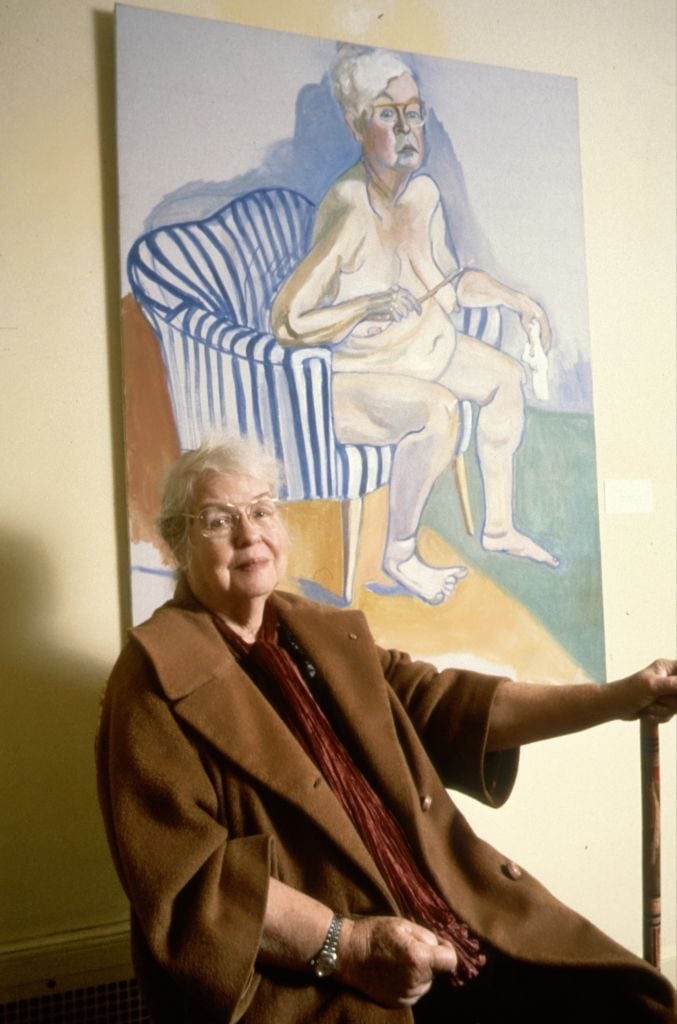







 Magnifying Glass
Magnifying Glass






